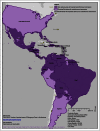Epidemiology of Chikungunya in the Americas
- PMID: 27920170
- PMCID: PMC5137246
- DOI: 10.1093/infdis/jiw390
Epidemiology of Chikungunya in the Americas
Abstract
Chikungunya virus (CHIKV) emerged in the Americas in late 2013 to cause substantial acute and chronic morbidity. About 1.1 million cases of chikungunya were reported within a year, including severe cases and deaths. The burden of chikungunya is unclear owing to inadequate disease surveillance and underdiagnosis. Virus evolution, globalization, and climate change may further CHIKV spread. No approved vaccine or antiviral therapeutics exist. Early detection and appropriate management could reduce the burden of severe atypical and chronic arthritic disease. Improved surveillance and risk assessment are needed to mitigate the impact of chikungunya.
Keywords: Americas; arbovirus; chikungunya; emerging disease; epidemiology.
© 2016 World Health Organization; licensee Oxford Journals.
Figures
References
-
- Staples JE, Breiman RF, Powers AM. Chikungunya fever: an epidemiological review of a re-emerging infectious disease. Clin Infect Dis 2009; 49:942–8. - PubMed
-
- Nakkhara P, Chongsuvivatwong V, Thammapalo S. Risk factors for symptomatic and asymptomatic chikungunya infection. Trans R Soc Trop Med Hyg 2013; 107:789–96. - PubMed
MeSH terms
Grants and funding
LinkOut - more resources
Full Text Sources
Other Literature Sources
Medical


